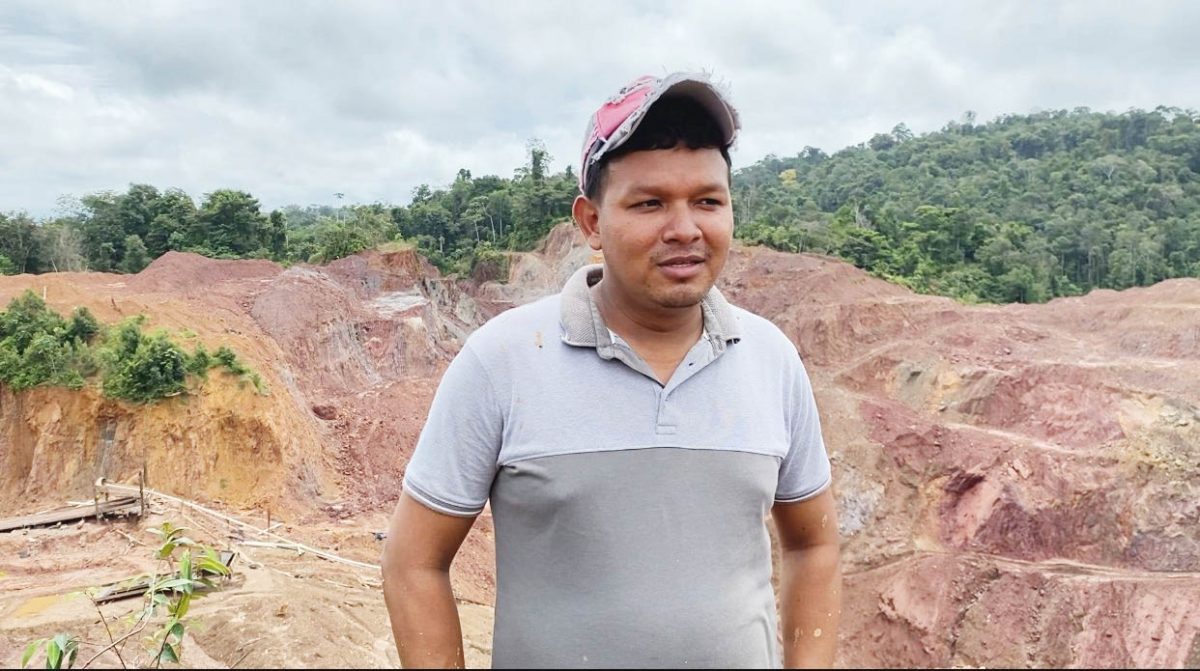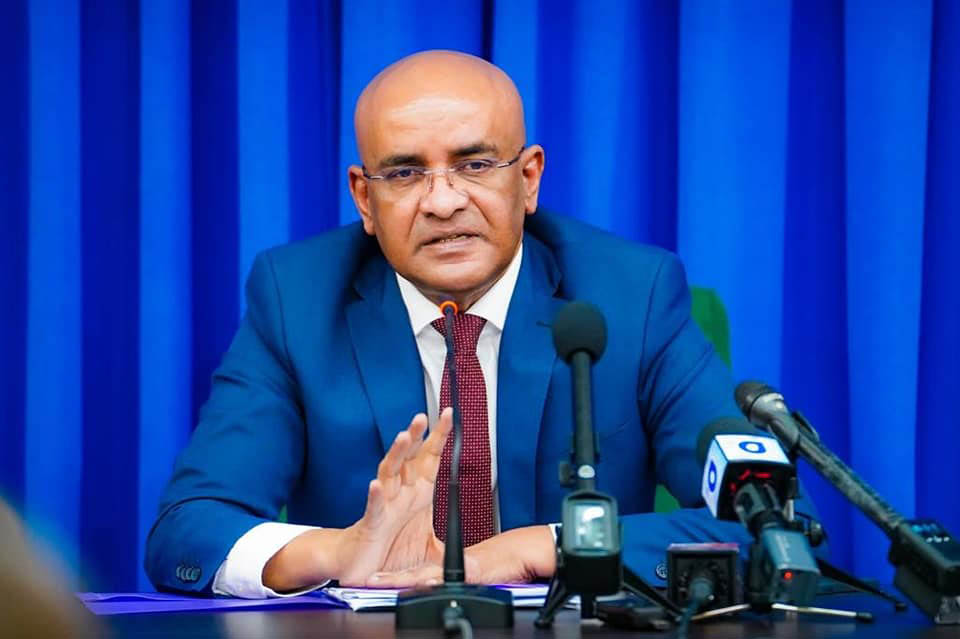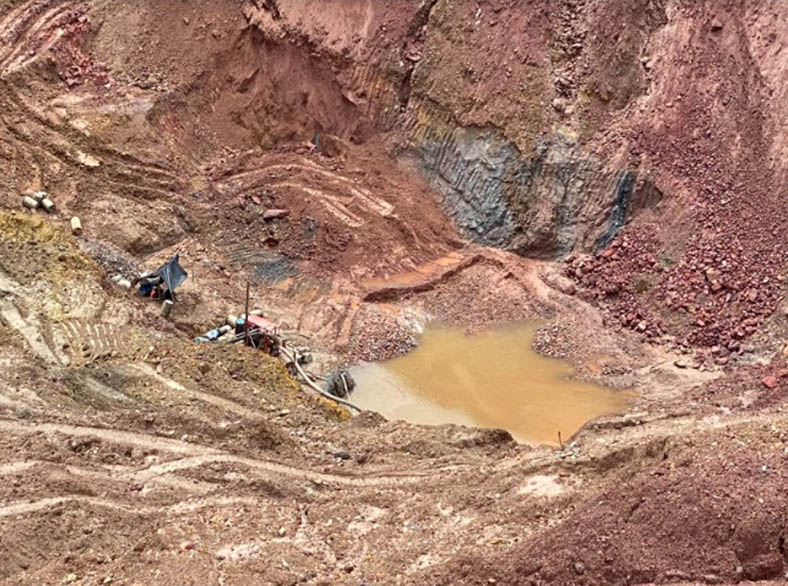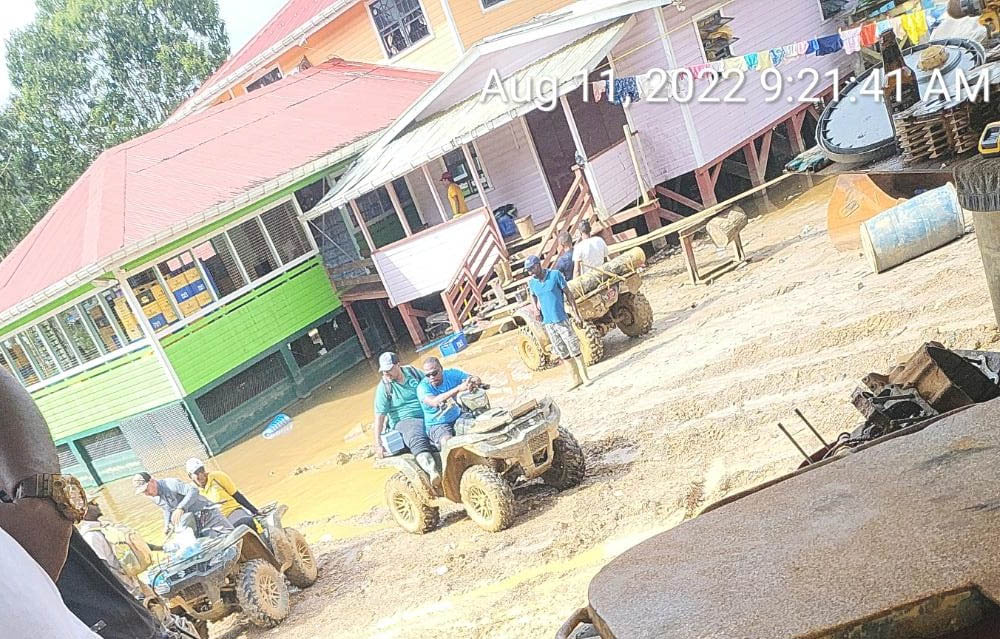Toshao of Chinese Landing Orin Fernandes has said officers from the Guyana Geology and Mines Commission (GGMC) and the Environment Protection Agency (EPA) who recently visited the community concluded that there are no glaring violations at the Tassawini mines.
The report to the Village Council was presented on Saturday last following a three-day visit to the Region One indigenous community by a team of officers from both agencies. The officers told Fernandes that they were responding to a series of reports that were published in “a newspaper”.
On Wednesday, August 10, three officers from the GGMC and two from the EPA ventured to Chinese Landing, where they met with Fernandes and informed him that they are there to carry out an investigation of Sunday Stabroek’s reports. However, Fernandes said that the miners were already aware of the visit days before the team arrived and they hid several pieces of illegal equipment and over half of the miners travelled to nearby villages where they stayed until the officers concluded their assessment.
Interestingly, the GGMC/EPA team was transported into Chinese Landing in boats belonging to the miners and then to the mines on ATVs owned by the same miners they were investigating. Fernandes and the Village Council offered to accompany the officers to the mines but their offer was refused, with the team saying that they preferred to work alone to avoid a conflict of interest.
On Saturday, August 13, the team met with Fernandes and the Village Council to present their preliminary findings. During an interview with this publication, Fernandes said that the officers informed them that they assessed several aspects of the operations belonging to Wayne Vieira, a businessman from Houston, East Bank Demerara and the overall conclusion was the situation is “all normal.”
“They said that everything was normal. The officers said that they looked at the licensing and documentation of equipment and so on. So they say when they carry out that [they say] 11 to 13 [pieces of] equipment and they are all registered in Vieira name. They say that those are legal to work and they cannot do nothing about that or stop those equipment from working once it’s in Vieira name because the mining permits is in Vieira name. He is the legal owner and have legal rights over the minerals there,” he said.
The team told the Village Council that during their assessment they found that the equipment was not in operation. They also said that an assessment of the mining pits was conducted and revealed that they were unsafe.
During the meeting, Fernandes and his team raised the issue of the machinery being hidden in preparation for the visit. Additionally, they questioned about whether tests were conducted for mercury.
“We raised the awareness of the other operations that are hidden up and so on as they normally do and then they’re asking us if we are willing to go back and show them were these equipment were. It was late already. Why tell us to go only now when we had insisted when they visited to be a part of the team with them. We wanted to be a part in the assessment or investigation to see whereby we can help and that was one of the way we could have helped in finding equipment that are hidden. So we think was just a waste of time to now go back and do that when they already done their assessment,” he related.
“Another concern that we asked if they took samples to test for mercury. The EPA team respond that they did a hurry-up trip and they didn’t prepare for [mercury testing] because doing mercury tests means that they gotta carry the samples to a lab within a certain amount of time, and so on,” he added.
He said that the team did a turbidity test on the river and creek in the area where the readings showed above normal. Fernandes explained that they told the team that the assessment was a waste of time because the illegal mining will continue.
The Tassawini mines are located in the centre of Chinese Landing – a titled indigenous village – and has been allocated to Vieira. The village has said that it was done without their free, prior and informed consent which is in violation of the Amerindian Act of 2006.
Sunday Stabroek visited the community from August 1 and spent three days during which a visit to the mines was conducted. It was related that approximately 500 miners are occupying the mining blocks within the community, threatening both the health and livelihood of the community members. On its visit to the mines, this newspaper observed that the deepest mining pit is approximately 500ft deep – which is no longer considered sub-surface mining.
Fernandes had accompanied this newspaper to the pit and he was shocked by the devastation. What also stood out was the fact that the toshao had to seek permission to visit the mines from the operators there although it falls within the community. Fernandes explained that it was necessary since the miners had threatened them with prosecution for trespassing on several occasions.
The road leading to the mines has severely deteriorated and according to the Village Council, the residents had been maintaining it because Vieira nor the government is interested in doing so.
Also, the environmental impacts of mining at Tassawini are visible since the waters were somewhat murky. The miners there are using mercury to extract the gold and it is released into the Tassawini Creek, which flows into the savannahs and into Huri Creek.
“…the tailing [residue from mercury] runs into our big savannah and spread in to there and then it run into the Tassawini Creek and then the Tassawini Creek runs straight into Huri Creek. This Huri Creek is our natural boundary, it runs all the way back to Kariako and then it comes into Barama. So the tailing whatever you use there it has to run into Huri Creek even if you bar it off and it break away it runs straight into Huri Creek and into Barama,” Fernandes had said.
Those creeks and savannah are the fishing grounds for Chinese Landing people as well as their main water sources. Now they are forced to look at alternatives owing to the pollution from mining. Fernandes had tested for above-normal levels of mercury in his system and had to undergo treatment.
During Sunday Stabroek’s visit to the mines, several children were observed in the area, which is prohibited. Also, there are shops directly where mining is happening, which is also prohibited.
“We have all of these shops and children here and the GGMC people and wardens not doing anything about it. This is not supposed to be happening and if it was us doing that then we would have been shut down long time now,” Deputy Toshao Vera Millington had said.
Complicit government officials
Meanwhile, at a press conference on Friday, Vice President Bharrat Jagdeo said that the government has always been on the side of the community of Chinese Landing. His comments came even after the Minister of Amerindian Affairs said that no more assistance can be rendered to the community, while adding that “other representatives looking after their interests” should be asked how they are assisting the community.
Jagdeo referenced the recent meeting with Toshao Fernandes and the Village Council where the issue was discussed.
“It was explained to them that throughout this process, GGMC and the government was on their side. The other party [Vieira] secured a ruling from the CCJ. Now the reason is that the permit to mine was issued before the Amerindian Act [of 2006] and so it presented some complications. So the CCJ ruled that the GGMC cannot enforce the Amerindian Act, they can only enforce breaches of the Act,” Jagdeo said on Saturday.
The village received its Certificate of Title on August 10, 2018, for 30.06 square miles or 19,241 acres of land. Between September 25, 1998, and September 26, 2001, four mining permits were issued to Vieira, to mine in the Tassawini area. The mining blocks fall in the centre of the community’s titled lands and have been its main source of income from time immemorial. Just last year, the High Court also dismissed a challenge brought by the community against Vieira. That judgment is currently being appealed.
Jagdeo said the government is aware of the breaches of the Act by the miners as well as threats made to the leader and Council. Jagdeo also expressed surprise at the visit by the team from GGMC and EPA.
“The President ordered also at that meeting there be a surprise visit…every time there is a planned raid the people know long before and they hide the equipment and so the President ordered a surprise raid on this area. To my surprise, I saw that apparently a visit was made and the very people was showing the staff of the GGMC around.
“…so we are not going to tolerate any violation of people’s rights and so this is happening it seems with the complicity of some individuals at the junior level of the government,” Jagdeo said.
In a letter to the editor, former Prime Minister Sam Hinds – who had long been responsible for overseeing the mining sector – argued that with all protections in place a win-win solution is a possibility if mutual respect could be attained and retained. He noted that it can be accomplished in the context of President Irfaan Ali’s ‘One Guyana’ initiative.
In a statement, the Guyana Human Rights Association (GHRA) said that the notion that the protective provisions of the Amerindian Act remain non-applicable over a decade after the Act came into force “is patently absurd.” It argued that the Act is intended to support and protect the villages and it is time for the government to start enforcing it.
In August of 1999, the Village Council at the time entered into an agreement with Vieira where he was permitted to mine on its land in exchange for 1% royalty. However, Vieira continually breached the agreement and it was terminated on April 27, 2004.
After the dismissal of the case, the Chinese Landing Village Council approached the United Nations Committee on the Elimination of Racial Discrimination (UN CERD) and complained about a number of violations under the Amerindian Act. The Council had submitted that these violations are being perpetrated by both the government and miners, who were granted permission to operate on titled, customary and sacred lands within their communities.
Contending that the government granted a medium-scale mining concession to Vieira in its titled lands without consulting or seeking the consent of the community, Chinese Landing had informed UNCERD that there has been an increase in unwanted mining which poses a risk to its traditional way of life and its environment. It further alleged that a High Court dismissal, without a hearing, of a claim filed by the community against the Guyana Geology and Mines Commission (GGMC) and Vieira concerning the mining concession has also resulted in an upsurge of a series of incidents of intimidation and assaults on residents of the community, by miners and members of the Guyanese Police Force.
UNCERD, in identifying areas for the government to take measures on, has since proposed consideration be given to suspending or revoking the mining concessions that affect the lands, territories or resources of the Chinese Landing and the Wapichan indigenous peoples until free, prior and informed consent (FPIC) is granted by the indigenous peoples; refraining from approving projects and granting mining permits or concessions within the lands of indigenous peoples, whether titled or not; ensuring that Indigenous Peoples have access to effective and prompt judicial and other remedies to seek protection for their rights; prevent and investigate incidents of threats and violence against residents of the Chinese Landing indigenous community by miners and by members of the Guyanese Police Force; incorporating the principle of FPIC in domestic legislation, including by amending the Amerindian Act of 2006, with indigenous peoples’ participation, and to fully and adequately guarantee the right to consultation of indigenous peoples; and considering ratifying ILO Indigenous and Tribal Peoples Convention (No. 169).
For now, the community of Chinese Landing is waiting to see what the next step that UN CERD recommends and is also hoping that government can act. They have also written to UN CERD, after the July 15 deadline set for government to respond, informing that no action has been taken by the government.









